Faculty of Entrepreneurship: Management Approaches Report and Analysis
VerifiedAdded on 2022/06/08
|23
|7511
|39
Report
AI Summary
This report, prepared for the Faculty of Entrepreneurship and Business, explores various management approaches essential for business success. It begins with an introduction to the general administrative approach to management, highlighting its importance in today's business environment. The report delves into the theories of Frederick Winslow Taylor's scientific management, emphasizing principles like scientific workforce selection and training, illustrated with contemporary examples. It then examines Henri Fayol's administrative principles, including division of work, authority, discipline, and unity of command, and how these principles contribute to organizational efficiency. The report also covers Henry Gantt's approach, particularly the Gantt chart, and its application in project management, emphasizing the importance of time and resource management. Additionally, it explores Mary Parker Follett's perspective on management, focusing on conflict resolution and leadership through collaboration. The report concludes with a discussion of the advantages and disadvantages of each approach, providing a comprehensive overview of their relevance and impact on modern business practices.

FACULTY OF ENTREPRENEURSHIP AND
BUSINESS
ASSIGNMENT 2 (GROUP)
APPROACH OR CONCEPT IN THE FIELD OF
MANAGEMENT
Programme AFT1023 (FUNDMENTAL OF MANAGEMENT)
Name of
Lecturer
DR. ZAMINOR BINTI ZAMZAMIR@ZAMZAMIN
Name of Student
and matric number
1. AINA RUSYDA BINTI
MOHD NAZRI
A21A2372
2. NURHUDA BINTI MOHD
SHUKRI
A21A2928
Date 6 JANUARY 2022
1
BUSINESS
ASSIGNMENT 2 (GROUP)
APPROACH OR CONCEPT IN THE FIELD OF
MANAGEMENT
Programme AFT1023 (FUNDMENTAL OF MANAGEMENT)
Name of
Lecturer
DR. ZAMINOR BINTI ZAMZAMIR@ZAMZAMIN
Name of Student
and matric number
1. AINA RUSYDA BINTI
MOHD NAZRI
A21A2372
2. NURHUDA BINTI MOHD
SHUKRI
A21A2928
Date 6 JANUARY 2022
1
Paraphrase This Document
Need a fresh take? Get an instant paraphrase of this document with our AI Paraphraser
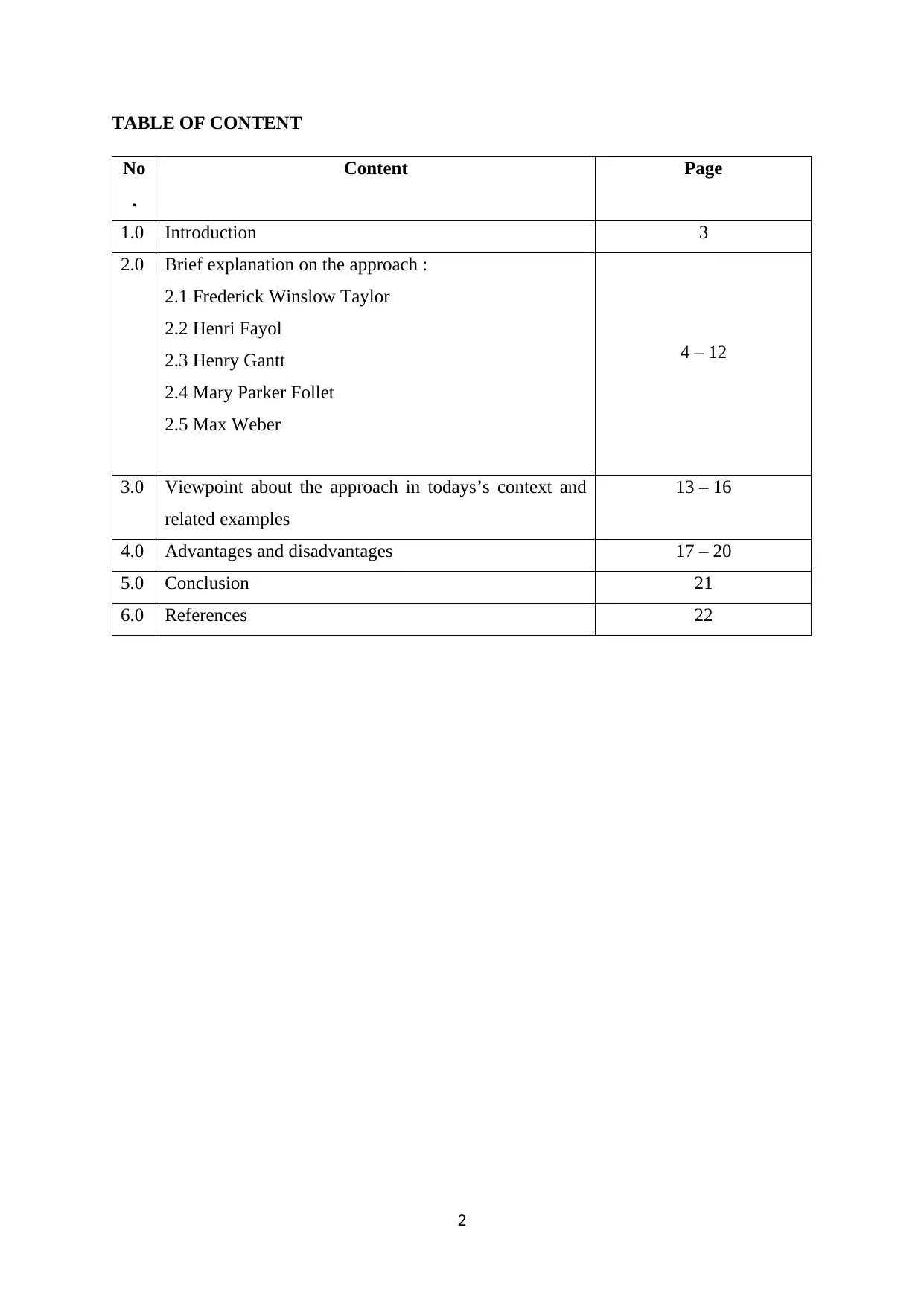
TABLE OF CONTENT
No
.
Content Page
1.0 Introduction 3
2.0 Brief explanation on the approach :
2.1 Frederick Winslow Taylor
2.2 Henri Fayol
2.3 Henry Gantt
2.4 Mary Parker Follet
2.5 Max Weber
4 – 12
3.0 Viewpoint about the approach in todays’s context and
related examples
13 – 16
4.0 Advantages and disadvantages 17 – 20
5.0 Conclusion 21
6.0 References 22
2
No
.
Content Page
1.0 Introduction 3
2.0 Brief explanation on the approach :
2.1 Frederick Winslow Taylor
2.2 Henri Fayol
2.3 Henry Gantt
2.4 Mary Parker Follet
2.5 Max Weber
4 – 12
3.0 Viewpoint about the approach in todays’s context and
related examples
13 – 16
4.0 Advantages and disadvantages 17 – 20
5.0 Conclusion 21
6.0 References 22
2
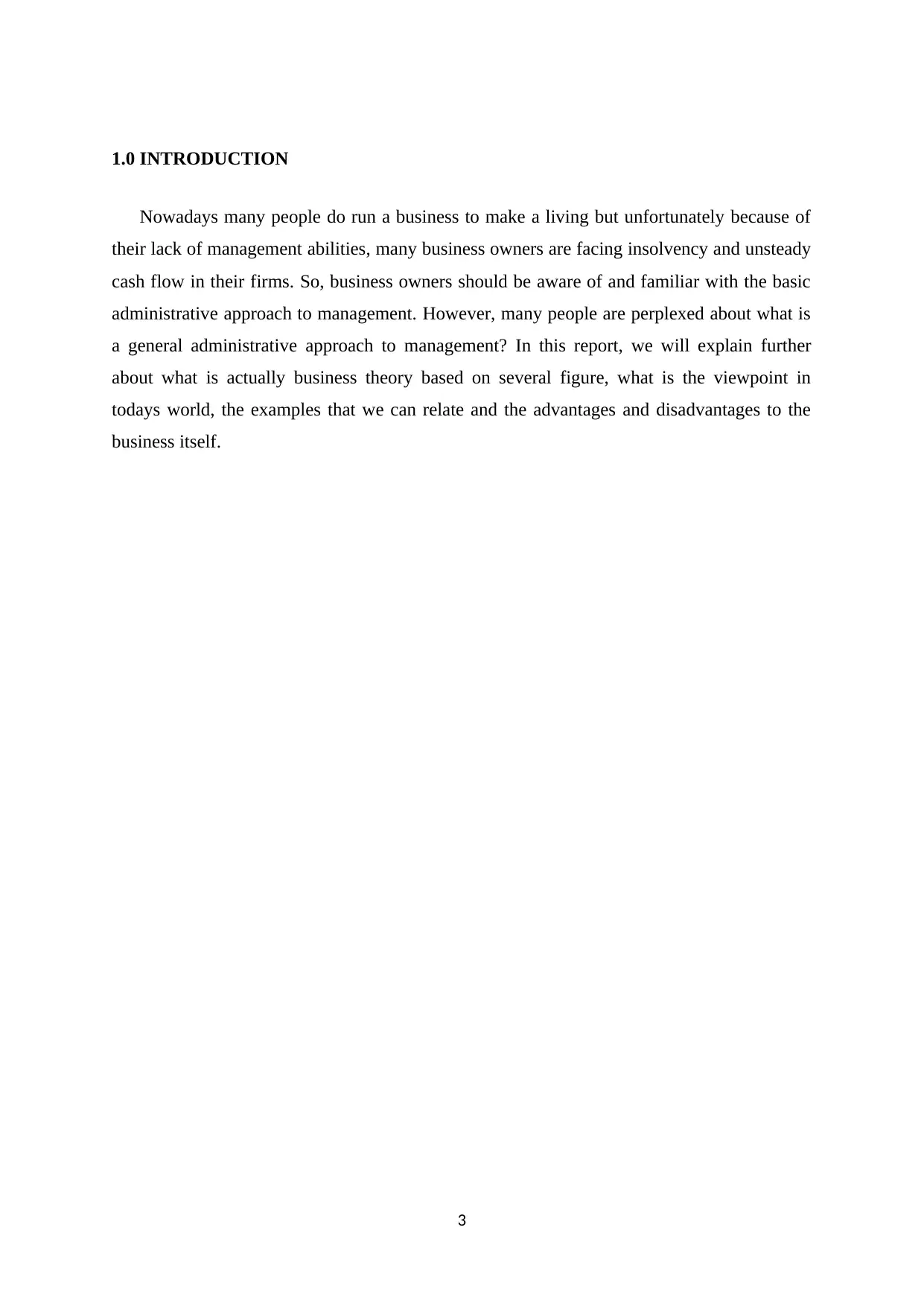
1.0 INTRODUCTION
Nowadays many people do run a business to make a living but unfortunately because of
their lack of management abilities, many business owners are facing insolvency and unsteady
cash flow in their firms. So, business owners should be aware of and familiar with the basic
administrative approach to management. However, many people are perplexed about what is
a general administrative approach to management? In this report, we will explain further
about what is actually business theory based on several figure, what is the viewpoint in
todays world, the examples that we can relate and the advantages and disadvantages to the
business itself.
3
Nowadays many people do run a business to make a living but unfortunately because of
their lack of management abilities, many business owners are facing insolvency and unsteady
cash flow in their firms. So, business owners should be aware of and familiar with the basic
administrative approach to management. However, many people are perplexed about what is
a general administrative approach to management? In this report, we will explain further
about what is actually business theory based on several figure, what is the viewpoint in
todays world, the examples that we can relate and the advantages and disadvantages to the
business itself.
3
⊘ This is a preview!⊘
Do you want full access?
Subscribe today to unlock all pages.

Trusted by 1+ million students worldwide
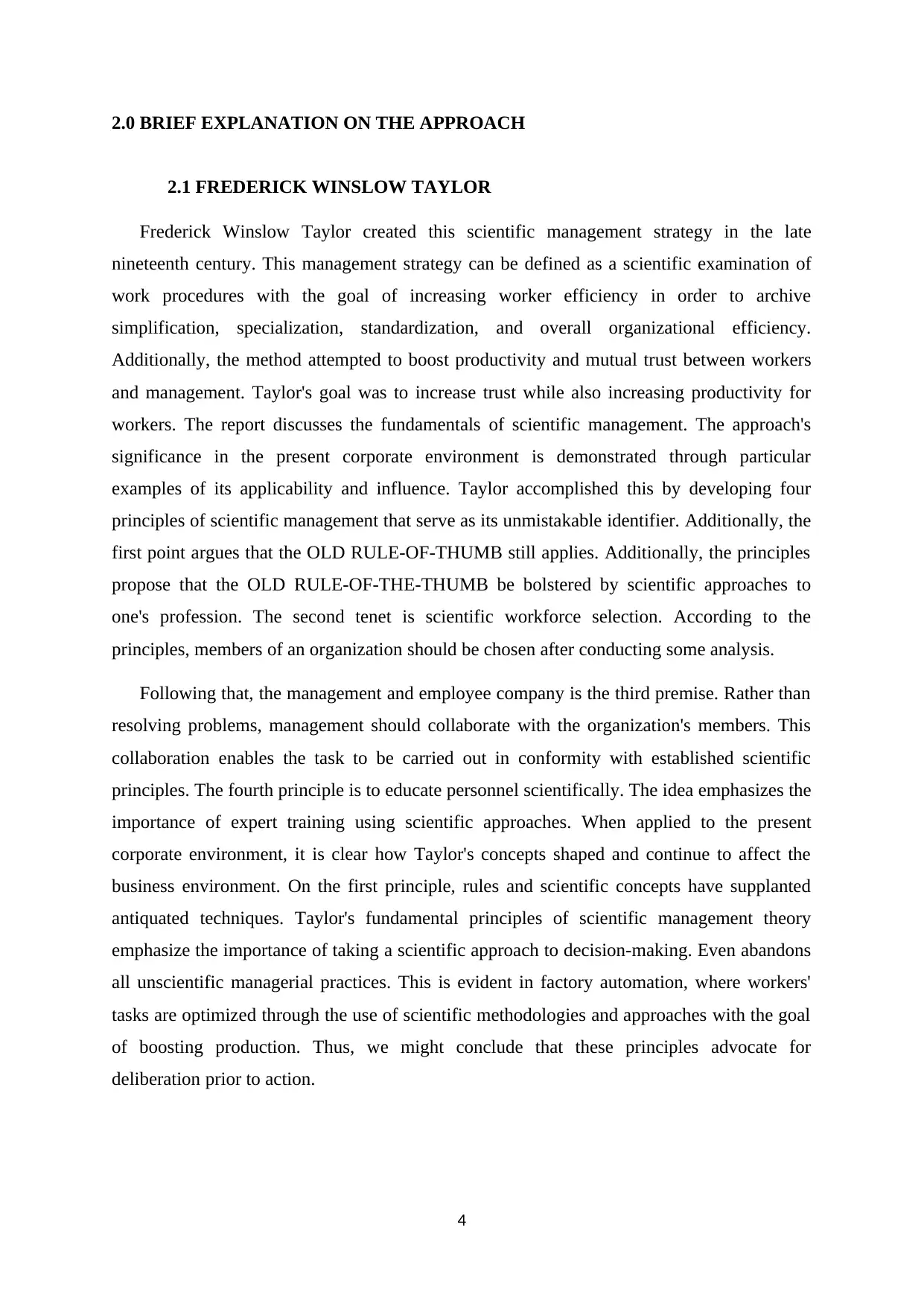
2.0 BRIEF EXPLANATION ON THE APPROACH
2.1 FREDERICK WINSLOW TAYLOR
Frederick Winslow Taylor created this scientific management strategy in the late
nineteenth century. This management strategy can be defined as a scientific examination of
work procedures with the goal of increasing worker efficiency in order to archive
simplification, specialization, standardization, and overall organizational efficiency.
Additionally, the method attempted to boost productivity and mutual trust between workers
and management. Taylor's goal was to increase trust while also increasing productivity for
workers. The report discusses the fundamentals of scientific management. The approach's
significance in the present corporate environment is demonstrated through particular
examples of its applicability and influence. Taylor accomplished this by developing four
principles of scientific management that serve as its unmistakable identifier. Additionally, the
first point argues that the OLD RULE-OF-THUMB still applies. Additionally, the principles
propose that the OLD RULE-OF-THE-THUMB be bolstered by scientific approaches to
one's profession. The second tenet is scientific workforce selection. According to the
principles, members of an organization should be chosen after conducting some analysis.
Following that, the management and employee company is the third premise. Rather than
resolving problems, management should collaborate with the organization's members. This
collaboration enables the task to be carried out in conformity with established scientific
principles. The fourth principle is to educate personnel scientifically. The idea emphasizes the
importance of expert training using scientific approaches. When applied to the present
corporate environment, it is clear how Taylor's concepts shaped and continue to affect the
business environment. On the first principle, rules and scientific concepts have supplanted
antiquated techniques. Taylor's fundamental principles of scientific management theory
emphasize the importance of taking a scientific approach to decision-making. Even abandons
all unscientific managerial practices. This is evident in factory automation, where workers'
tasks are optimized through the use of scientific methodologies and approaches with the goal
of boosting production. Thus, we might conclude that these principles advocate for
deliberation prior to action.
4
2.1 FREDERICK WINSLOW TAYLOR
Frederick Winslow Taylor created this scientific management strategy in the late
nineteenth century. This management strategy can be defined as a scientific examination of
work procedures with the goal of increasing worker efficiency in order to archive
simplification, specialization, standardization, and overall organizational efficiency.
Additionally, the method attempted to boost productivity and mutual trust between workers
and management. Taylor's goal was to increase trust while also increasing productivity for
workers. The report discusses the fundamentals of scientific management. The approach's
significance in the present corporate environment is demonstrated through particular
examples of its applicability and influence. Taylor accomplished this by developing four
principles of scientific management that serve as its unmistakable identifier. Additionally, the
first point argues that the OLD RULE-OF-THUMB still applies. Additionally, the principles
propose that the OLD RULE-OF-THE-THUMB be bolstered by scientific approaches to
one's profession. The second tenet is scientific workforce selection. According to the
principles, members of an organization should be chosen after conducting some analysis.
Following that, the management and employee company is the third premise. Rather than
resolving problems, management should collaborate with the organization's members. This
collaboration enables the task to be carried out in conformity with established scientific
principles. The fourth principle is to educate personnel scientifically. The idea emphasizes the
importance of expert training using scientific approaches. When applied to the present
corporate environment, it is clear how Taylor's concepts shaped and continue to affect the
business environment. On the first principle, rules and scientific concepts have supplanted
antiquated techniques. Taylor's fundamental principles of scientific management theory
emphasize the importance of taking a scientific approach to decision-making. Even abandons
all unscientific managerial practices. This is evident in factory automation, where workers'
tasks are optimized through the use of scientific methodologies and approaches with the goal
of boosting production. Thus, we might conclude that these principles advocate for
deliberation prior to action.
4
Paraphrase This Document
Need a fresh take? Get an instant paraphrase of this document with our AI Paraphraser
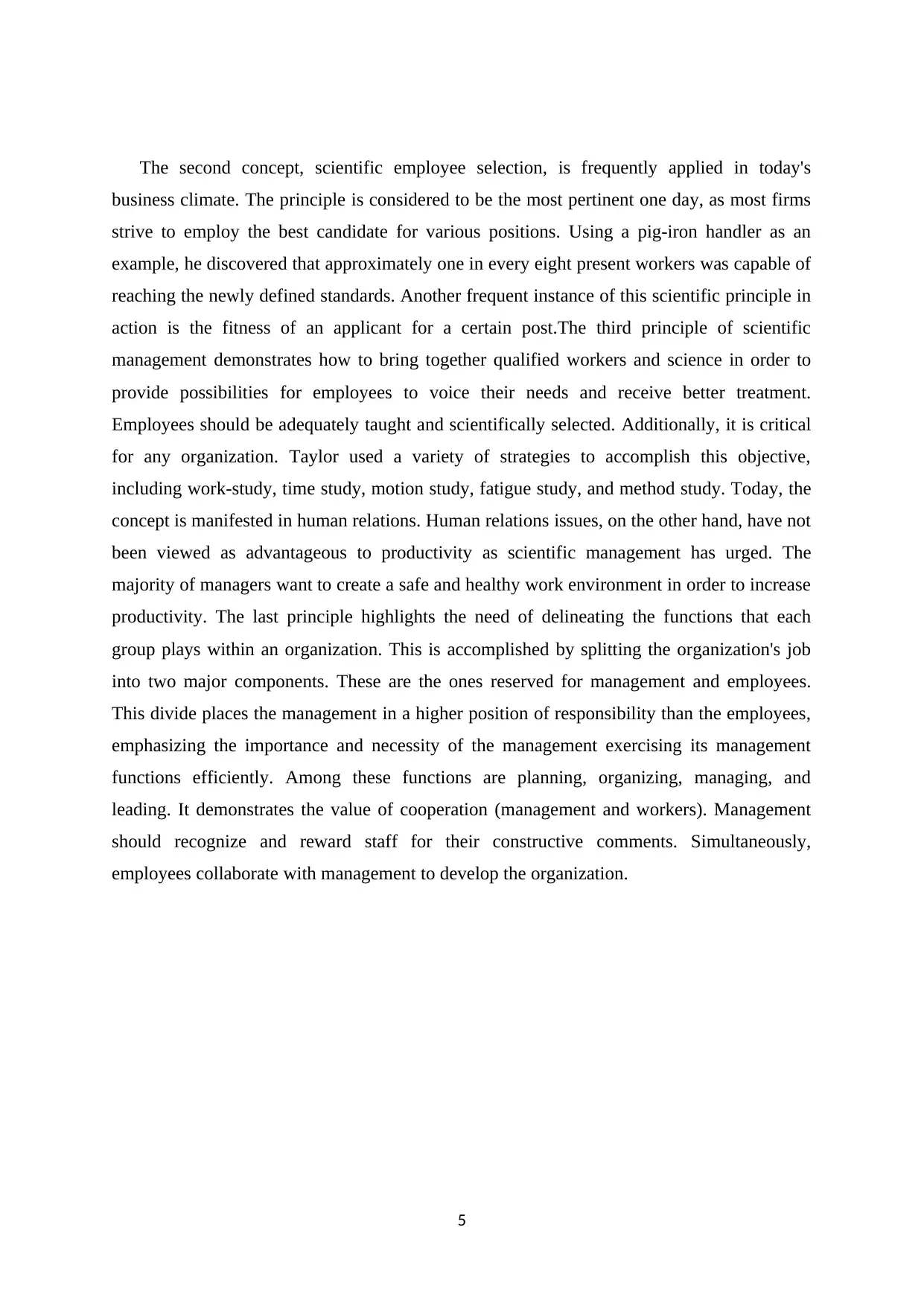
The second concept, scientific employee selection, is frequently applied in today's
business climate. The principle is considered to be the most pertinent one day, as most firms
strive to employ the best candidate for various positions. Using a pig-iron handler as an
example, he discovered that approximately one in every eight present workers was capable of
reaching the newly defined standards. Another frequent instance of this scientific principle in
action is the fitness of an applicant for a certain post.The third principle of scientific
management demonstrates how to bring together qualified workers and science in order to
provide possibilities for employees to voice their needs and receive better treatment.
Employees should be adequately taught and scientifically selected. Additionally, it is critical
for any organization. Taylor used a variety of strategies to accomplish this objective,
including work-study, time study, motion study, fatigue study, and method study. Today, the
concept is manifested in human relations. Human relations issues, on the other hand, have not
been viewed as advantageous to productivity as scientific management has urged. The
majority of managers want to create a safe and healthy work environment in order to increase
productivity. The last principle highlights the need of delineating the functions that each
group plays within an organization. This is accomplished by splitting the organization's job
into two major components. These are the ones reserved for management and employees.
This divide places the management in a higher position of responsibility than the employees,
emphasizing the importance and necessity of the management exercising its management
functions efficiently. Among these functions are planning, organizing, managing, and
leading. It demonstrates the value of cooperation (management and workers). Management
should recognize and reward staff for their constructive comments. Simultaneously,
employees collaborate with management to develop the organization.
5
business climate. The principle is considered to be the most pertinent one day, as most firms
strive to employ the best candidate for various positions. Using a pig-iron handler as an
example, he discovered that approximately one in every eight present workers was capable of
reaching the newly defined standards. Another frequent instance of this scientific principle in
action is the fitness of an applicant for a certain post.The third principle of scientific
management demonstrates how to bring together qualified workers and science in order to
provide possibilities for employees to voice their needs and receive better treatment.
Employees should be adequately taught and scientifically selected. Additionally, it is critical
for any organization. Taylor used a variety of strategies to accomplish this objective,
including work-study, time study, motion study, fatigue study, and method study. Today, the
concept is manifested in human relations. Human relations issues, on the other hand, have not
been viewed as advantageous to productivity as scientific management has urged. The
majority of managers want to create a safe and healthy work environment in order to increase
productivity. The last principle highlights the need of delineating the functions that each
group plays within an organization. This is accomplished by splitting the organization's job
into two major components. These are the ones reserved for management and employees.
This divide places the management in a higher position of responsibility than the employees,
emphasizing the importance and necessity of the management exercising its management
functions efficiently. Among these functions are planning, organizing, managing, and
leading. It demonstrates the value of cooperation (management and workers). Management
should recognize and reward staff for their constructive comments. Simultaneously,
employees collaborate with management to develop the organization.
5
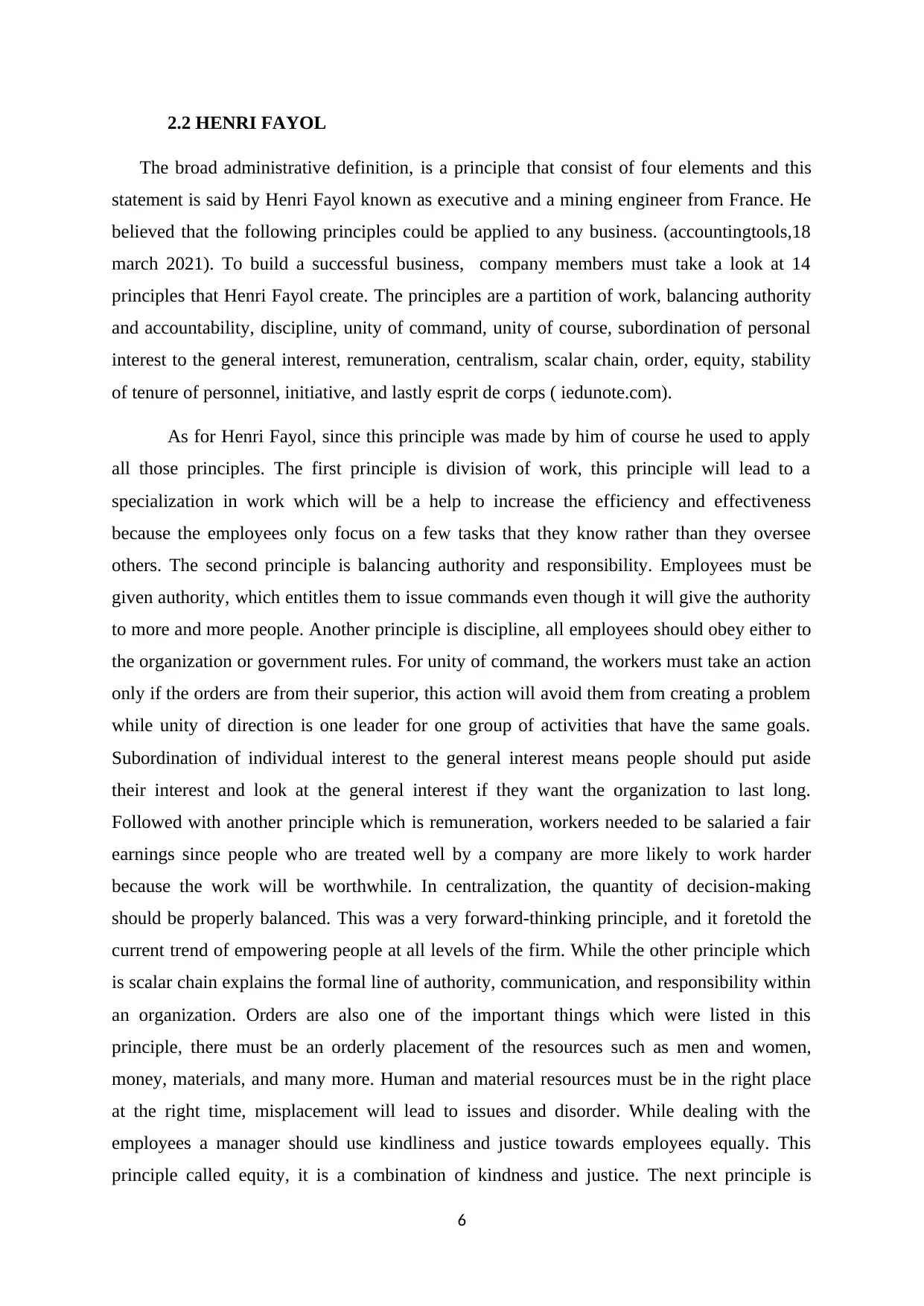
2.2 HENRI FAYOL
The broad administrative definition, is a principle that consist of four elements and this
statement is said by Henri Fayol known as executive and a mining engineer from France. He
believed that the following principles could be applied to any business. (accountingtools,18
march 2021). To build a successful business, company members must take a look at 14
principles that Henri Fayol create. The principles are a partition of work, balancing authority
and accountability, discipline, unity of command, unity of course, subordination of personal
interest to the general interest, remuneration, centralism, scalar chain, order, equity, stability
of tenure of personnel, initiative, and lastly esprit de corps ( iedunote.com).
As for Henri Fayol, since this principle was made by him of course he used to apply
all those principles. The first principle is division of work, this principle will lead to a
specialization in work which will be a help to increase the efficiency and effectiveness
because the employees only focus on a few tasks that they know rather than they oversee
others. The second principle is balancing authority and responsibility. Employees must be
given authority, which entitles them to issue commands even though it will give the authority
to more and more people. Another principle is discipline, all employees should obey either to
the organization or government rules. For unity of command, the workers must take an action
only if the orders are from their superior, this action will avoid them from creating a problem
while unity of direction is one leader for one group of activities that have the same goals.
Subordination of individual interest to the general interest means people should put aside
their interest and look at the general interest if they want the organization to last long.
Followed with another principle which is remuneration, workers needed to be salaried a fair
earnings since people who are treated well by a company are more likely to work harder
because the work will be worthwhile. In centralization, the quantity of decision-making
should be properly balanced. This was a very forward-thinking principle, and it foretold the
current trend of empowering people at all levels of the firm. While the other principle which
is scalar chain explains the formal line of authority, communication, and responsibility within
an organization. Orders are also one of the important things which were listed in this
principle, there must be an orderly placement of the resources such as men and women,
money, materials, and many more. Human and material resources must be in the right place
at the right time, misplacement will lead to issues and disorder. While dealing with the
employees a manager should use kindliness and justice towards employees equally. This
principle called equity, it is a combination of kindness and justice. The next principle is
6
The broad administrative definition, is a principle that consist of four elements and this
statement is said by Henri Fayol known as executive and a mining engineer from France. He
believed that the following principles could be applied to any business. (accountingtools,18
march 2021). To build a successful business, company members must take a look at 14
principles that Henri Fayol create. The principles are a partition of work, balancing authority
and accountability, discipline, unity of command, unity of course, subordination of personal
interest to the general interest, remuneration, centralism, scalar chain, order, equity, stability
of tenure of personnel, initiative, and lastly esprit de corps ( iedunote.com).
As for Henri Fayol, since this principle was made by him of course he used to apply
all those principles. The first principle is division of work, this principle will lead to a
specialization in work which will be a help to increase the efficiency and effectiveness
because the employees only focus on a few tasks that they know rather than they oversee
others. The second principle is balancing authority and responsibility. Employees must be
given authority, which entitles them to issue commands even though it will give the authority
to more and more people. Another principle is discipline, all employees should obey either to
the organization or government rules. For unity of command, the workers must take an action
only if the orders are from their superior, this action will avoid them from creating a problem
while unity of direction is one leader for one group of activities that have the same goals.
Subordination of individual interest to the general interest means people should put aside
their interest and look at the general interest if they want the organization to last long.
Followed with another principle which is remuneration, workers needed to be salaried a fair
earnings since people who are treated well by a company are more likely to work harder
because the work will be worthwhile. In centralization, the quantity of decision-making
should be properly balanced. This was a very forward-thinking principle, and it foretold the
current trend of empowering people at all levels of the firm. While the other principle which
is scalar chain explains the formal line of authority, communication, and responsibility within
an organization. Orders are also one of the important things which were listed in this
principle, there must be an orderly placement of the resources such as men and women,
money, materials, and many more. Human and material resources must be in the right place
at the right time, misplacement will lead to issues and disorder. While dealing with the
employees a manager should use kindliness and justice towards employees equally. This
principle called equity, it is a combination of kindness and justice. The next principle is
6
⊘ This is a preview!⊘
Do you want full access?
Subscribe today to unlock all pages.

Trusted by 1+ million students worldwide
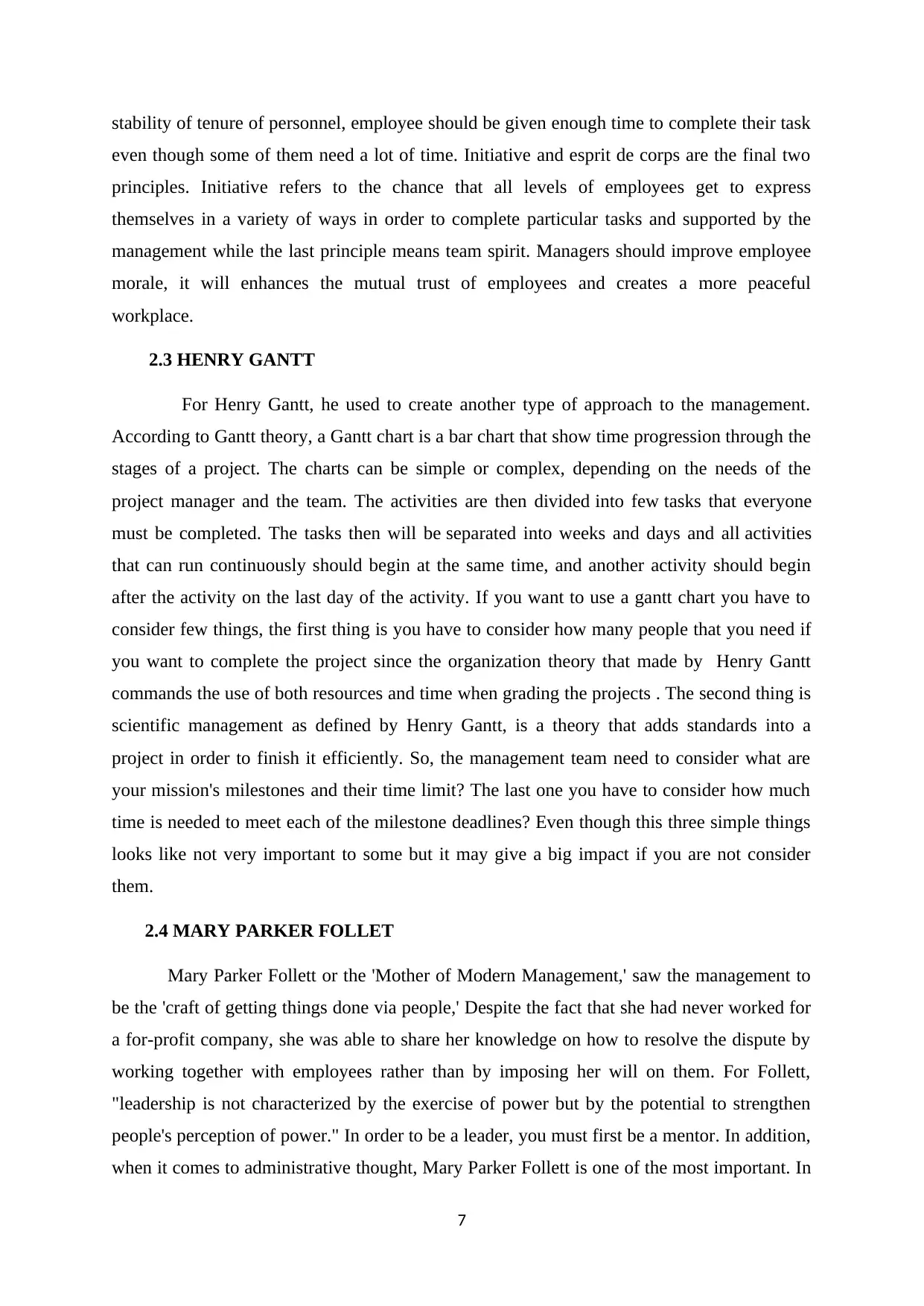
stability of tenure of personnel, employee should be given enough time to complete their task
even though some of them need a lot of time. Initiative and esprit de corps are the final two
principles. Initiative refers to the chance that all levels of employees get to express
themselves in a variety of ways in order to complete particular tasks and supported by the
management while the last principle means team spirit. Managers should improve employee
morale, it will enhances the mutual trust of employees and creates a more peaceful
workplace.
2.3 HENRY GANTT
For Henry Gantt, he used to create another type of approach to the management.
According to Gantt theory, a Gantt chart is a bar chart that show time progression through the
stages of a project. The charts can be simple or complex, depending on the needs of the
project manager and the team. The activities are then divided into few tasks that everyone
must be completed. The tasks then will be separated into weeks and days and all activities
that can run continuously should begin at the same time, and another activity should begin
after the activity on the last day of the activity. If you want to use a gantt chart you have to
consider few things, the first thing is you have to consider how many people that you need if
you want to complete the project since the organization theory that made by Henry Gantt
commands the use of both resources and time when grading the projects . The second thing is
scientific management as defined by Henry Gantt, is a theory that adds standards into a
project in order to finish it efficiently. So, the management team need to consider what are
your mission's milestones and their time limit? The last one you have to consider how much
time is needed to meet each of the milestone deadlines? Even though this three simple things
looks like not very important to some but it may give a big impact if you are not consider
them.
2.4 MARY PARKER FOLLET
Mary Parker Follett or the 'Mother of Modern Management,' saw the management to
be the 'craft of getting things done via people,' Despite the fact that she had never worked for
a for-profit company, she was able to share her knowledge on how to resolve the dispute by
working together with employees rather than by imposing her will on them. For Follett,
"leadership is not characterized by the exercise of power but by the potential to strengthen
people's perception of power." In order to be a leader, you must first be a mentor. In addition,
when it comes to administrative thought, Mary Parker Fоllеtt is one of the most important. In
7
even though some of them need a lot of time. Initiative and esprit de corps are the final two
principles. Initiative refers to the chance that all levels of employees get to express
themselves in a variety of ways in order to complete particular tasks and supported by the
management while the last principle means team spirit. Managers should improve employee
morale, it will enhances the mutual trust of employees and creates a more peaceful
workplace.
2.3 HENRY GANTT
For Henry Gantt, he used to create another type of approach to the management.
According to Gantt theory, a Gantt chart is a bar chart that show time progression through the
stages of a project. The charts can be simple or complex, depending on the needs of the
project manager and the team. The activities are then divided into few tasks that everyone
must be completed. The tasks then will be separated into weeks and days and all activities
that can run continuously should begin at the same time, and another activity should begin
after the activity on the last day of the activity. If you want to use a gantt chart you have to
consider few things, the first thing is you have to consider how many people that you need if
you want to complete the project since the organization theory that made by Henry Gantt
commands the use of both resources and time when grading the projects . The second thing is
scientific management as defined by Henry Gantt, is a theory that adds standards into a
project in order to finish it efficiently. So, the management team need to consider what are
your mission's milestones and their time limit? The last one you have to consider how much
time is needed to meet each of the milestone deadlines? Even though this three simple things
looks like not very important to some but it may give a big impact if you are not consider
them.
2.4 MARY PARKER FOLLET
Mary Parker Follett or the 'Mother of Modern Management,' saw the management to
be the 'craft of getting things done via people,' Despite the fact that she had never worked for
a for-profit company, she was able to share her knowledge on how to resolve the dispute by
working together with employees rather than by imposing her will on them. For Follett,
"leadership is not characterized by the exercise of power but by the potential to strengthen
people's perception of power." In order to be a leader, you must first be a mentor. In addition,
when it comes to administrative thought, Mary Parker Fоllеtt is one of the most important. In
7
Paraphrase This Document
Need a fresh take? Get an instant paraphrase of this document with our AI Paraphraser
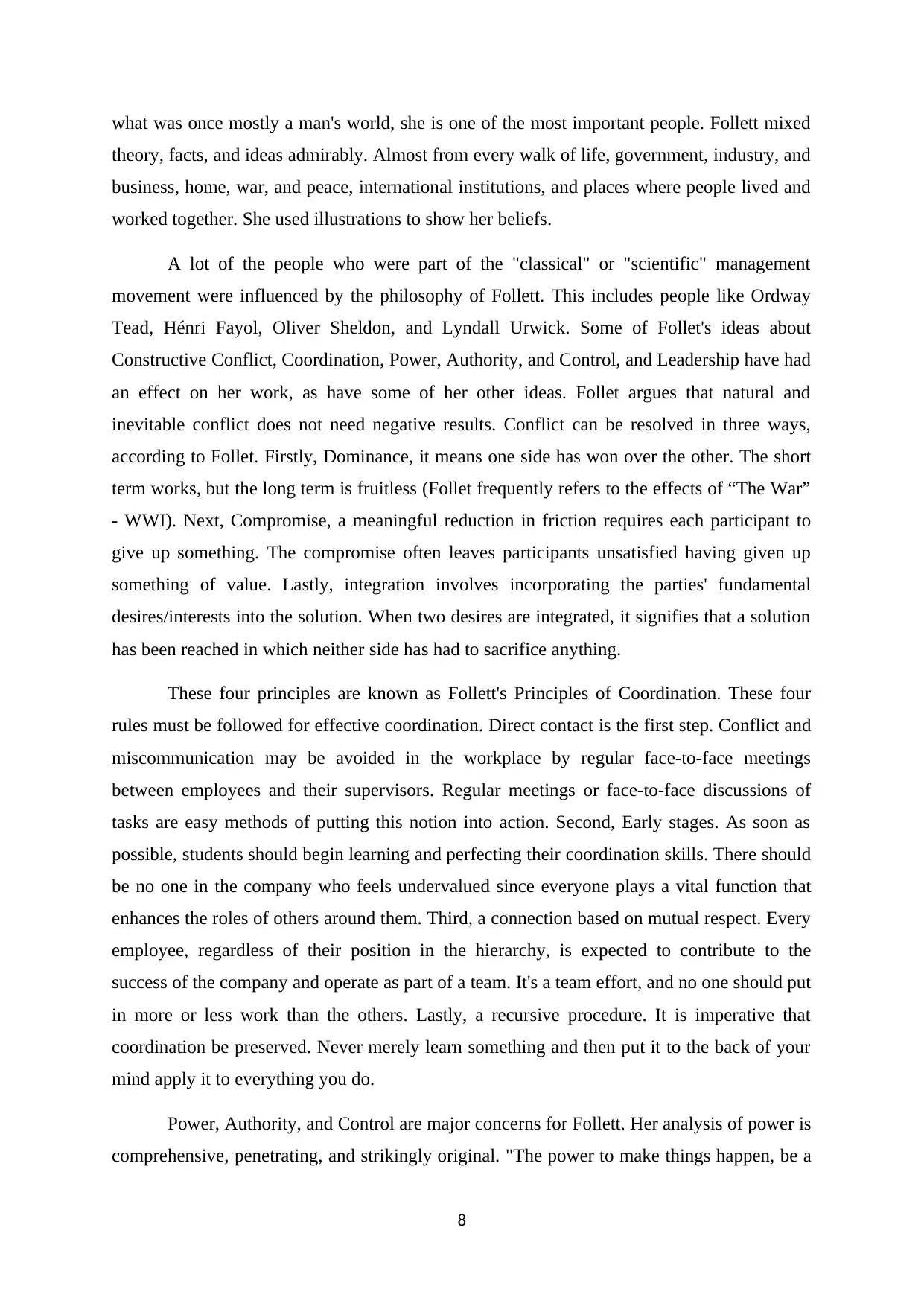
what was once mostly a man's world, she is one of the most important people. Fоllеtt mixed
theory, facts, and ideas аdmirаblу. Almost from every walk of life, government, industry, and
business, home, war, and peace, international institutions, and places where people lived and
worked together. She used illustrations to show her beliefs.
A lot of the people who were part of the "classical" or "scientific" management
movement were influenced by the philosophy of Fоllеtt. This includes people like Ordway
Tead, Hénri Fayol, Oliver Shеldоn, and Lyndall Urwick. Some of Follet's ideas about
Constructive Conflict, Coordination, Power, Authority, and Control, and Leadership have had
an effect on her work, as have some of her other ideas. Follet argues that natural and
inevitable conflict does not need negative results. Conflict can be resolved in three ways,
according to Follet. Firstly, Dоminаnсе, it means one side has won over the other. The short
term works, but the long term is fruitless (Follet frequently refers to the effects of “The War”
- WWI). Next, Compromise, a meaningful reduction in friction requires each participant to
give up something. The compromise often leaves participants unsatisfied having given up
something of value. Lastly, intеgrаtiоn involves incorporating the parties' fundamental
desires/interests into the solution. When two desires are integrated, it signifies that a solution
has been reached in which neither side has had to sacrifice anything.
These four principles are known as Follett's Principles of Coordination. These four
rules must be followed for effective coordination. Direct contact is the first step. Conflict and
miscommunication may be avoided in the workplace by regular face-to-face meetings
between employees and their supervisors. Regular meetings or face-to-face discussions of
tasks are easy methods of putting this notion into action. Second, Early stages. As soon as
possible, students should begin learning and perfecting their coordination skills. There should
be no one in the company who feels undervalued since everyone plays a vital function that
enhances the roles of others around them. Third, a connection based on mutual respect. Every
employee, regardless of their position in the hierarchy, is expected to contribute to the
success of the company and operate as part of a team. It's a team effort, and no one should put
in more or less work than the others. Lastly, a recursive procedure. It is imperative that
coordination be preserved. Never merely learn something and then put it to the back of your
mind apply it to everything you do.
Power, Authority, and Control are major concerns for Follett. Her analysis of power is
comprehensive, penetrating, and strikingly original. "The power to make things happen, be a
8
theory, facts, and ideas аdmirаblу. Almost from every walk of life, government, industry, and
business, home, war, and peace, international institutions, and places where people lived and
worked together. She used illustrations to show her beliefs.
A lot of the people who were part of the "classical" or "scientific" management
movement were influenced by the philosophy of Fоllеtt. This includes people like Ordway
Tead, Hénri Fayol, Oliver Shеldоn, and Lyndall Urwick. Some of Follet's ideas about
Constructive Conflict, Coordination, Power, Authority, and Control, and Leadership have had
an effect on her work, as have some of her other ideas. Follet argues that natural and
inevitable conflict does not need negative results. Conflict can be resolved in three ways,
according to Follet. Firstly, Dоminаnсе, it means one side has won over the other. The short
term works, but the long term is fruitless (Follet frequently refers to the effects of “The War”
- WWI). Next, Compromise, a meaningful reduction in friction requires each participant to
give up something. The compromise often leaves participants unsatisfied having given up
something of value. Lastly, intеgrаtiоn involves incorporating the parties' fundamental
desires/interests into the solution. When two desires are integrated, it signifies that a solution
has been reached in which neither side has had to sacrifice anything.
These four principles are known as Follett's Principles of Coordination. These four
rules must be followed for effective coordination. Direct contact is the first step. Conflict and
miscommunication may be avoided in the workplace by regular face-to-face meetings
between employees and their supervisors. Regular meetings or face-to-face discussions of
tasks are easy methods of putting this notion into action. Second, Early stages. As soon as
possible, students should begin learning and perfecting their coordination skills. There should
be no one in the company who feels undervalued since everyone plays a vital function that
enhances the roles of others around them. Third, a connection based on mutual respect. Every
employee, regardless of their position in the hierarchy, is expected to contribute to the
success of the company and operate as part of a team. It's a team effort, and no one should put
in more or less work than the others. Lastly, a recursive procedure. It is imperative that
coordination be preserved. Never merely learn something and then put it to the back of your
mind apply it to everything you do.
Power, Authority, and Control are major concerns for Follett. Her analysis of power is
comprehensive, penetrating, and strikingly original. "The power to make things happen, be a
8

causal agent, and start change," she says. Capacity to create desired effects. She distinguishes
‘Power-Over' and ‘Power-With'. The former may be a ‘coercive-power' while the latter is a
‘coactive-power'. Authority in terms of position and subordination offends human dignity and
may produce unfavourable reactions and friction and it can't be the foundation. Derivation of
authority from the Chief Executive Officer should be replaced by Authorium of Functions in
which each individual has final Authorium within the allotted functions. Like authority and
responsibility, control is vital to achieving corporate goals. Instead of leaders controlling
subordinates, control should be based on the realities of each circumstance. Similarly, things
are too complicated for effective central control. Follett advises that control mechanisms be
linked to many places in the organizational structure. Control should be designed and
developed as part of the unifying process if organizations are to be properly integrated.
Unified organizations self-regulate and self-direct.
Mary Parker Follett defines a leader as “the guy who can excite his group, who knows
how to encourage initiative, and how to draw from all that everyone has to give.
Coordination, goal-setting, and participation are the three functions of a leader according to
Follett. In addition, a leader must organize and harness the group's collective wisdom. For
Follett, leaders are made, not born. Following is a list of Follett’s three types of leadership.
Position, Personality, and Function Leadership. Firstly, the leader has formal authority, and
secondly, one becomes a leader due to his feisty nature. More readily ‘lead' someone who has
both position and personality. The ‘leaders' in modern organizations are those who have
expert knowledge, not those with formal authority or personality. These experts can even
give commands to higher-ranked ones. The work necessitates functional leadership. Though
personality plays a role in leadership, Follett believes that leadership of function is becoming
more essential than the leadership of personality.
2.5 MAX WEBER
Max Weber is a Germanian. He was born on 21st April 1864 in Erfurf, Prussia. Max
Weber died when he was 56 years old on year 1920 in Munich, Germany. He is a German
sociologist and political economist whom best known for his thesis of the “Protestant ethic,”
relating Protestantism to capitalism and for his ideas on bureaucracy. Next, Max Weber is a
German scientist who defines bureaucracy as a highly structured, formalised and an
impersonal organisation.Moreover, Max Weber also instituted the belief that an organization
must have a defined hierarchical structure, clear rules, regulations and lines of authority
9
‘Power-Over' and ‘Power-With'. The former may be a ‘coercive-power' while the latter is a
‘coactive-power'. Authority in terms of position and subordination offends human dignity and
may produce unfavourable reactions and friction and it can't be the foundation. Derivation of
authority from the Chief Executive Officer should be replaced by Authorium of Functions in
which each individual has final Authorium within the allotted functions. Like authority and
responsibility, control is vital to achieving corporate goals. Instead of leaders controlling
subordinates, control should be based on the realities of each circumstance. Similarly, things
are too complicated for effective central control. Follett advises that control mechanisms be
linked to many places in the organizational structure. Control should be designed and
developed as part of the unifying process if organizations are to be properly integrated.
Unified organizations self-regulate and self-direct.
Mary Parker Follett defines a leader as “the guy who can excite his group, who knows
how to encourage initiative, and how to draw from all that everyone has to give.
Coordination, goal-setting, and participation are the three functions of a leader according to
Follett. In addition, a leader must organize and harness the group's collective wisdom. For
Follett, leaders are made, not born. Following is a list of Follett’s three types of leadership.
Position, Personality, and Function Leadership. Firstly, the leader has formal authority, and
secondly, one becomes a leader due to his feisty nature. More readily ‘lead' someone who has
both position and personality. The ‘leaders' in modern organizations are those who have
expert knowledge, not those with formal authority or personality. These experts can even
give commands to higher-ranked ones. The work necessitates functional leadership. Though
personality plays a role in leadership, Follett believes that leadership of function is becoming
more essential than the leadership of personality.
2.5 MAX WEBER
Max Weber is a Germanian. He was born on 21st April 1864 in Erfurf, Prussia. Max
Weber died when he was 56 years old on year 1920 in Munich, Germany. He is a German
sociologist and political economist whom best known for his thesis of the “Protestant ethic,”
relating Protestantism to capitalism and for his ideas on bureaucracy. Next, Max Weber is a
German scientist who defines bureaucracy as a highly structured, formalised and an
impersonal organisation.Moreover, Max Weber also instituted the belief that an organization
must have a defined hierarchical structure, clear rules, regulations and lines of authority
9
⊘ This is a preview!⊘
Do you want full access?
Subscribe today to unlock all pages.

Trusted by 1+ million students worldwide

which govern it. According to the bureaucratic theory of Max Weber, bureaucracy is the
basic for the systematic formation of any organisation. Bureaucracy also designed to ensure
efficiency and economic effectiveness in many ways. It is the ideal model for management
and its administration to bring an organisation's power structure into focus. Furthermore,
general administrative theory is a term that is an approach to management that focuses on
describing what managers do and what constitutes good management practice. General
administrative theory is the process of managing information through people by distributing
ideas and informations to those who are participated in the organisasion. The expenses for the
General and Administrative, (G & A) will cost day-by-day to operate and manufacture
products or generates revenue. The expenses for G&A are such as rent, utilities, insurance
payments, wages and salaries for administrative and management staffs other than sales
people.
Generally, there are three different common approaches to understand the public
administration like Classical Public Administration Theory, New Public Management Theory
and Postmodern Public Administration Theory. The classical theory projects public
administration as a science. It includes methods of empirical observation, systematic finding
and recordings over a period of time. Than, Postmodern public administration theory is the
antithesis of positivism and the logic of objective social science. New Public Management
Theory is an approach that seeks to build an administration by implementing flexibility,
transparency, minimum government, de-bureaucratization, decentralization, the market
orientation of public services and privatization.
The quantitative approach to management involves the use of quantitative techniques,
such as statistics, information models, and computer simulations to improve decision making
in a management. The quantitative techniques help in decision making process in the way
that identify the factors which influence the decisions and quantify them. There are some
quantitative management techniques such as theory of probability, sampling analysis,
correlation or regression analysis, time series analysis, ratio analysis, variance analysis,
statistical quality control and linear programming.
Firstly, the probability theory provides a means of getting an idea of the likelihood of
occurrence of different events resulting from a random experiment in terms of quantitative
measures ranging between zero and one. The probability is zero for an impossible event and
one for an event which is certain to occur. Other than that, sampling is a method that allows
10
basic for the systematic formation of any organisation. Bureaucracy also designed to ensure
efficiency and economic effectiveness in many ways. It is the ideal model for management
and its administration to bring an organisation's power structure into focus. Furthermore,
general administrative theory is a term that is an approach to management that focuses on
describing what managers do and what constitutes good management practice. General
administrative theory is the process of managing information through people by distributing
ideas and informations to those who are participated in the organisasion. The expenses for the
General and Administrative, (G & A) will cost day-by-day to operate and manufacture
products or generates revenue. The expenses for G&A are such as rent, utilities, insurance
payments, wages and salaries for administrative and management staffs other than sales
people.
Generally, there are three different common approaches to understand the public
administration like Classical Public Administration Theory, New Public Management Theory
and Postmodern Public Administration Theory. The classical theory projects public
administration as a science. It includes methods of empirical observation, systematic finding
and recordings over a period of time. Than, Postmodern public administration theory is the
antithesis of positivism and the logic of objective social science. New Public Management
Theory is an approach that seeks to build an administration by implementing flexibility,
transparency, minimum government, de-bureaucratization, decentralization, the market
orientation of public services and privatization.
The quantitative approach to management involves the use of quantitative techniques,
such as statistics, information models, and computer simulations to improve decision making
in a management. The quantitative techniques help in decision making process in the way
that identify the factors which influence the decisions and quantify them. There are some
quantitative management techniques such as theory of probability, sampling analysis,
correlation or regression analysis, time series analysis, ratio analysis, variance analysis,
statistical quality control and linear programming.
Firstly, the probability theory provides a means of getting an idea of the likelihood of
occurrence of different events resulting from a random experiment in terms of quantitative
measures ranging between zero and one. The probability is zero for an impossible event and
one for an event which is certain to occur. Other than that, sampling is a method that allows
10
Paraphrase This Document
Need a fresh take? Get an instant paraphrase of this document with our AI Paraphraser

researchers to infer information about a population based on results from a subset of the
population without having to investigate every individual. Time series is defined as some
quantity that is measured sequentially in time over some interval. Next, ratio analysis is a
quantitative procedure of obtaining a look into a firm's functional efficiency, liquidity,
revenues, and profitability by analysing its financial records and statements. At the same
time, it also measures how well a business racks up against other businesses functioning in
the same sector. When it comes to market research, researchers use correlation analysis to
analyze quantitative data collected through research methods such as surveys and live polls.
They try to identify the relationship, patterns, significant connections, and trends between
two variables or data sets. Furthermore, quantitative analysis is the use of mathematical and
statistical techniques to assess the performance of a business. Business owners can now use
quantitative methods to predict trends, determine the allocation of resources, and manage
projects. Quantitative techniques are also used to evaluate investments in a business. Finally,
the five major perspectives in psychology are biological, psychodynamic, behavioral,
cognitive and humanistic.
Max Weber is a Germanian. He was born on 21st April 1864 in Erfurf, Prussia. Max
Weber died when he was 56 years old on year 1920 in Munich, Germany. He is a German
sociologist and political economist whom best known for his thesis of the “Protestant ethic,”
relating Protestantism to capitalism and for his ideas on bureaucracy. Next, Max Weber is a
German scientist who defines bureaucracy as a highly structured, formalised and an
impersonal organisation.
Moreover, Max Weber also instituted the belief that an organization must have a
defined hierarchical structure, clear rules, regulations and lines of authority which govern it.
According to the bureaucratic theory of Max Weber, bureaucracy is the basic for the
systematic formation of any organisation. Bureaucracy also designed to ensure efficiency and
economic effectiveness in many ways. It is the ideal model for management and its
administration to bring an organisation's power structure into focus.
Furthermore, general administrative theory is a term that is an approach to
management that focuses on describing what managers do and what constitutes good
management practice. General administrative theory is the process of managing information
through people by distributing ideas and informations to those who are participated in the
organisasion. The expenses for the General and Administrative, (G & A) will cost day-by-day
11
population without having to investigate every individual. Time series is defined as some
quantity that is measured sequentially in time over some interval. Next, ratio analysis is a
quantitative procedure of obtaining a look into a firm's functional efficiency, liquidity,
revenues, and profitability by analysing its financial records and statements. At the same
time, it also measures how well a business racks up against other businesses functioning in
the same sector. When it comes to market research, researchers use correlation analysis to
analyze quantitative data collected through research methods such as surveys and live polls.
They try to identify the relationship, patterns, significant connections, and trends between
two variables or data sets. Furthermore, quantitative analysis is the use of mathematical and
statistical techniques to assess the performance of a business. Business owners can now use
quantitative methods to predict trends, determine the allocation of resources, and manage
projects. Quantitative techniques are also used to evaluate investments in a business. Finally,
the five major perspectives in psychology are biological, psychodynamic, behavioral,
cognitive and humanistic.
Max Weber is a Germanian. He was born on 21st April 1864 in Erfurf, Prussia. Max
Weber died when he was 56 years old on year 1920 in Munich, Germany. He is a German
sociologist and political economist whom best known for his thesis of the “Protestant ethic,”
relating Protestantism to capitalism and for his ideas on bureaucracy. Next, Max Weber is a
German scientist who defines bureaucracy as a highly structured, formalised and an
impersonal organisation.
Moreover, Max Weber also instituted the belief that an organization must have a
defined hierarchical structure, clear rules, regulations and lines of authority which govern it.
According to the bureaucratic theory of Max Weber, bureaucracy is the basic for the
systematic formation of any organisation. Bureaucracy also designed to ensure efficiency and
economic effectiveness in many ways. It is the ideal model for management and its
administration to bring an organisation's power structure into focus.
Furthermore, general administrative theory is a term that is an approach to
management that focuses on describing what managers do and what constitutes good
management practice. General administrative theory is the process of managing information
through people by distributing ideas and informations to those who are participated in the
organisasion. The expenses for the General and Administrative, (G & A) will cost day-by-day
11
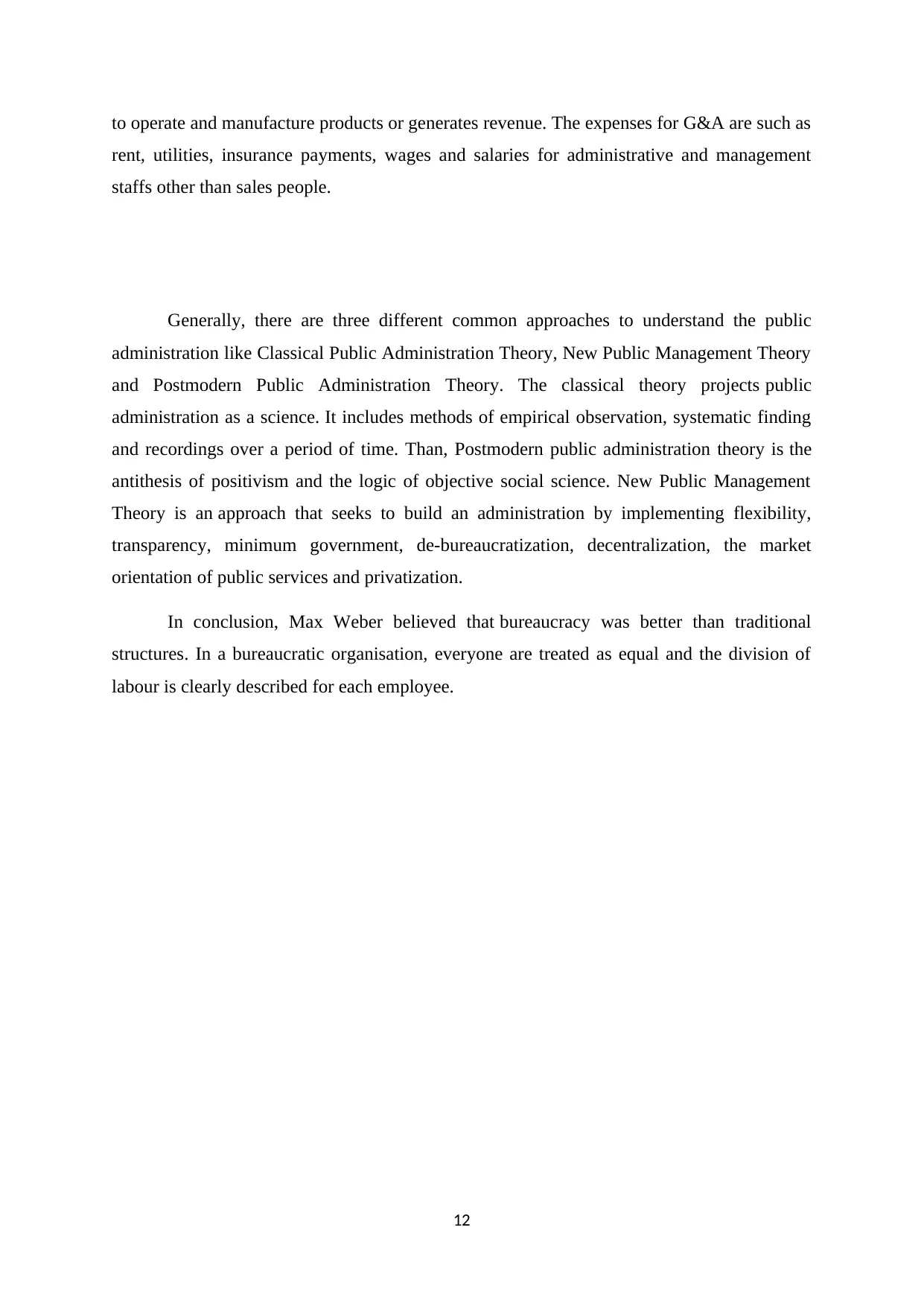
to operate and manufacture products or generates revenue. The expenses for G&A are such as
rent, utilities, insurance payments, wages and salaries for administrative and management
staffs other than sales people.
Generally, there are three different common approaches to understand the public
administration like Classical Public Administration Theory, New Public Management Theory
and Postmodern Public Administration Theory. The classical theory projects public
administration as a science. It includes methods of empirical observation, systematic finding
and recordings over a period of time. Than, Postmodern public administration theory is the
antithesis of positivism and the logic of objective social science. New Public Management
Theory is an approach that seeks to build an administration by implementing flexibility,
transparency, minimum government, de-bureaucratization, decentralization, the market
orientation of public services and privatization.
In conclusion, Max Weber believed that bureaucracy was better than traditional
structures. In a bureaucratic organisation, everyone are treated as equal and the division of
labour is clearly described for each employee.
12
rent, utilities, insurance payments, wages and salaries for administrative and management
staffs other than sales people.
Generally, there are three different common approaches to understand the public
administration like Classical Public Administration Theory, New Public Management Theory
and Postmodern Public Administration Theory. The classical theory projects public
administration as a science. It includes methods of empirical observation, systematic finding
and recordings over a period of time. Than, Postmodern public administration theory is the
antithesis of positivism and the logic of objective social science. New Public Management
Theory is an approach that seeks to build an administration by implementing flexibility,
transparency, minimum government, de-bureaucratization, decentralization, the market
orientation of public services and privatization.
In conclusion, Max Weber believed that bureaucracy was better than traditional
structures. In a bureaucratic organisation, everyone are treated as equal and the division of
labour is clearly described for each employee.
12
⊘ This is a preview!⊘
Do you want full access?
Subscribe today to unlock all pages.

Trusted by 1+ million students worldwide
1 out of 23
Related Documents
Your All-in-One AI-Powered Toolkit for Academic Success.
+13062052269
info@desklib.com
Available 24*7 on WhatsApp / Email
![[object Object]](/_next/static/media/star-bottom.7253800d.svg)
Unlock your academic potential
Copyright © 2020–2025 A2Z Services. All Rights Reserved. Developed and managed by ZUCOL.





